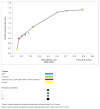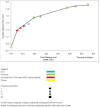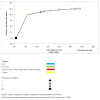Alternative antiretroviral monitoring strategies for HIV-infected patients in east Africa: opportunities to save more lives?
- PMID: 21801434
- PMCID: PMC3163507
- DOI: 10.1186/1758-2652-14-38
Alternative antiretroviral monitoring strategies for HIV-infected patients in east Africa: opportunities to save more lives?
Abstract
Background: Updated World Health Organization guidelines have amplified debate about how resource constraints should impact monitoring strategies for HIV-infected persons on combination antiretroviral therapy (cART). We estimated the incremental benefit and cost effectiveness of alternative monitoring strategies for east Africans with known HIV infection.
Methods: Using a validated HIV computer simulation based on resource-limited data (USAID and AMPATH) and circumstances (east Africa), we compared alternative monitoring strategies for HIV-infected persons newly started on cART. We evaluated clinical, immunologic and virologic monitoring strategies, including combinations and conditional logic (e.g., only perform virologic testing if immunologic testing is positive). We calculated incremental cost-effectiveness ratios (ICER) in units of cost per quality-adjusted life year (QALY), using a societal perspective and a lifetime horizon. Costs were measured in 2008 US dollars, and costs and benefits were discounted at 3%. We compared the ICER of monitoring strategies with those of other resource-constrained decisions, in particular earlier cART initiation (at CD4 counts of 350 cells/mm3 rather than 200 cells/mm3).
Results: Monitoring strategies employing routine CD4 testing without virologic testing never maximized health benefits, regardless of budget or societal willingness to pay for additional health benefits. Monitoring strategies employing virologic testing conditional upon particular CD4 results delivered the most benefit at willingness-to-pay levels similar to the cost of earlier cART initiation (approximately $2600/QALY). Monitoring strategies employing routine virologic testing alone only maximized health benefits at willingness-to-pay levels (> $4400/QALY) that greatly exceeded the ICER of earlier cART initiation.
Conclusions: CD4 testing alone never maximized health benefits regardless of resource limitations. Programmes routinely performing virologic testing but deferring cART initiation may increase health benefits by reallocating monitoring resources towards earlier cART initiation.
Figures





Similar articles
-
Optimal frequency of CD4 cell count and HIV RNA monitoring prior to initiation of antiretroviral therapy in HIV-infected patients.Antivir Ther. 2005;10(1):41-52. Antivir Ther. 2005. PMID: 15751762
-
How do different eligibility guidelines for antiretroviral therapy affect the cost-effectiveness of routine viral load testing in sub-Saharan Africa?AIDS. 2014 Jan;28 Suppl 1(0 1):S73-83. doi: 10.1097/QAD.0000000000000110. AIDS. 2014. PMID: 24468949 Free PMC article.
-
Pharmacy refill adherence compared with CD4 count changes for monitoring HIV-infected adults on antiretroviral therapy.PLoS Med. 2008 May 20;5(5):e109. doi: 10.1371/journal.pmed.0050109. PLoS Med. 2008. PMID: 18494555 Free PMC article.
-
Developments in CD4 and viral load monitoring in resource-limited settings.Clin Infect Dis. 2014 Feb;58(3):407-12. doi: 10.1093/cid/cit733. Epub 2013 Nov 11. Clin Infect Dis. 2014. PMID: 24218101 Free PMC article. Review.
-
Study of the impact of HIV genotypic drug resistance testing on therapy efficacy.Verh K Acad Geneeskd Belg. 2001;63(5):447-73. Verh K Acad Geneeskd Belg. 2001. PMID: 11813503 Review.
Cited by
-
Modeling the cost-effectiveness of HIV treatment: how to buy the most 'health' when resources are limited.Curr Opin HIV AIDS. 2013 Nov;8(6):544-9. doi: 10.1097/COH.0000000000000005. Curr Opin HIV AIDS. 2013. PMID: 24100874 Free PMC article. Review.
-
The cost-effectiveness of monitoring strategies for antiretroviral therapy of HIV infected patients in resource-limited settings: software tool.PLoS One. 2015 Mar 20;10(3):e0119299. doi: 10.1371/journal.pone.0119299. eCollection 2015. PLoS One. 2015. PMID: 25793531 Free PMC article.
-
Targeting an alcohol intervention cost-effectively to persons living with HIV/AIDS in East Africa.Alcohol Clin Exp Res. 2015 Nov;39(11):2179-88. doi: 10.1111/acer.12890. Epub 2015 Oct 14. Alcohol Clin Exp Res. 2015. PMID: 26463727 Free PMC article.
-
Is more research always needed? Estimating optimal sample sizes for trials of retention in care interventions for HIV-positive East Africans.BMJ Glob Health. 2017 Jul 20;2(2):e000195. doi: 10.1136/bmjgh-2016-000195. eCollection 2017. BMJ Glob Health. 2017. PMID: 29081993 Free PMC article.
-
Changing Cycle Lengths in State-Transition Models: Challenges and Solutions.Med Decis Making. 2016 Nov;36(8):952-64. doi: 10.1177/0272989X16656165. Epub 2016 Jul 1. Med Decis Making. 2016. PMID: 27369084 Free PMC article.
References
-
- Elliott JH, Lynen L, Calmy A, De Luca A, Shafer RW, Zolfo M, Clotet B, Huffam S, Boucher CA, Cooper DA, Schapiro JM. Rational use of antiretroviral therapy in low-income and middle-income countries: optimizing regimen sequencing and switching. AIDS. 2008;14:2053–2067. doi: 10.1097/QAD.0b013e328309520d. - DOI - PubMed
-
- Johannessen A, Garrido C, Zahonero N, Sandvik L, Naman E, Kivuyo SL, Kasubi MJ, Gundersen SG, Bruun JN, de Mendoza C. Dried blood spots perform well in viral load monitoring of patients who receive antiretroviral treatment in rural Tanzania. Clin Infect Dis. 2009;14:976–981. doi: 10.1086/605502. - DOI - PubMed
-
- Phillips AN, Pillay D, Miners AH, Bennett DE, Gilks CF, Lundgren JD. Outcomes from monitoring of patients on antiretroviral therapy in resource-limited settings with viral load, CD4 cell count, or clinical observation alone: a computer simulation model. Lancet. 2008;14:1443–1451. doi: 10.1016/S0140-6736(08)60624-8. - DOI - PubMed
Publication types
MeSH terms
Substances
Grants and funding
LinkOut - more resources
Full Text Sources
Medical
Research Materials

